Loïc LEDEZ - The French Master Projectionist |
Read more
at in70mm.com The 70mm Newsletter |
| Written by: Thomas Hauerslev | Date: 14.12.2007 |
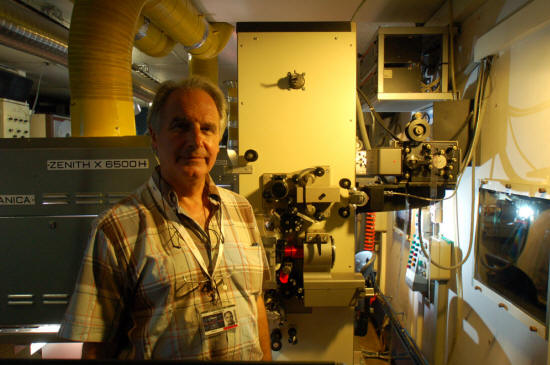 Loïc
LEDEZ in the Palais des Festivals in Cannes, May 2007. Image by Thomas Hauerslev Loïc
LEDEZ in the Palais des Festivals in Cannes, May 2007. Image by Thomas HauerslevMaking the most of his visit to the 2007 Cannes Film Festival, Thomas Hauerslev spoke with Loïc Ledez - The Master French Projectionist. If you type ‘Loïc Ledez’ into your Internet search engine it doesn’t take more than a few seconds to find the quote ‘Probably the most important person at the Cannes Film Festival’, a very rare tribute to a projectionist in a business where for most of the time projectionists are neither seen nor heard, and only noticed on the rare occasions that something goes wrong. I was therefore delighted that Loïc agreed to talk to me about his life and work. “I was born in 1945 in northern France, in Boulogne-sur-Mer, a big fishing port. My beginnings in projection rooms were made easier by my uncle, who owned a 35mm cinema in a small town near Boulogne. I remember that when I was five or six years old I would be allowed to rewind the movies which, at that time, were delivered in 300m reels. |
More
in 70mm reading: Postcards from Festival de Cannes 2007 On the Trail of CinemaScope A Picture Visit to Kinopanorama in Paris, 1990 Warner Bros. Pictures Celebrates 50 Years of Stanley Kubrick's "2001: A Space Odyssey" Internet link: |
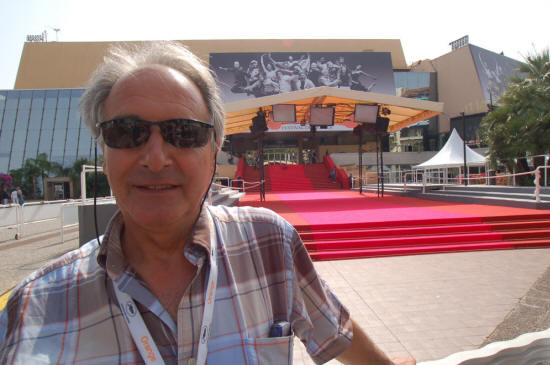 Loïc
LEDEZ outside the Palais de Festival in Cannes, May 2007. Image by Thomas
Hauerslev Loïc
LEDEZ outside the Palais de Festival in Cannes, May 2007. Image by Thomas
HauerslevA few years later, I was going to a catholic school where there was a small cinema using 16mm, with two Hortson arc projectors. This cinema used to operate on Saturdays and Sundays and I would sometimes project the films myself. This kind of cinema, managed by the parish church, was very common in the 50s and 60s. In the early 60s, I became an assistant projectionist in a new cinema in Boulogne, Le Coquelin, which was equipped with two Simplex XL projectors with Peerless arc lamps, a Peerless and Simplex audio chain and an auditorium with 1000 seats. In 1962 I was promoted to become the official projectionist of the Le Coquelin cinema. Two years later I had to do military service, from 1964-66, but in 1966 came back to Boulogne-sur-Mer and to the cinema Le Coquelin. A few months later I was involved with the installation of the 70mm projection facilities, using two DP70s. I still remember the first movie that I projected in 70mm: “Those Magnificent Men in their Flying Machines”. Then “Uncle Tom’s Cabin”, “My Fair Lady”, “It's a Mad Mad Mad Mad World”, “Old Shatterhand”, “The Agony and The Ecstasy”, “The Sound of Music”, etc. |
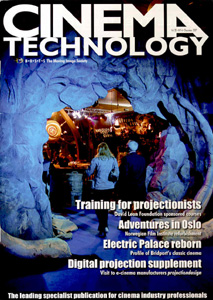 PDF:
Loïc LEDEZ - The
French Master Projectionist PDF:
Loïc LEDEZ - The
French Master Projectionist |
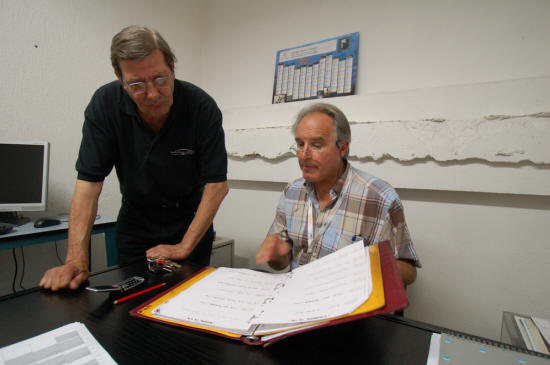 Loïc
LEDEZ in his office at the Palais des Festivals in Cannes, May 2007. Today, Loïc's tasks are mainly planning. Image by Thomas Hauerslev Loïc
LEDEZ in his office at the Palais des Festivals in Cannes, May 2007. Today, Loïc's tasks are mainly planning. Image by Thomas HauerslevI was fascinated by the cinema and decided that within the space of one year, I would learn all there was to know about cinema, from A to Z. In 1967, I was 21 and I went to Paris where I acted as a ‘stand-in’ projectionist for several months in studios, mixing and dubbing studios, laboratories, cinemas, gaining a vast amount of experience in all aspects of projection. It was also in Paris where I discovered the Cinerama projection rooms, watching “Khartoum”, “The Greatest Story Ever Told”, “Battle of the Bulge”, etc., not forgetting the Kinopanorama where, as a simple spectator at that time, I watched the 70mm soviet movies, “War And Peace”, and “An Optimistic Tragedy”. In 1971, at the Empire, in Paris, just before it was closed, I was lucky enough to see a 3-strip Cinerama festival, watching “This is Cinerama”, “How the West Was Won”, “The Wonderful World of the Brothers Grimm”.. |
|
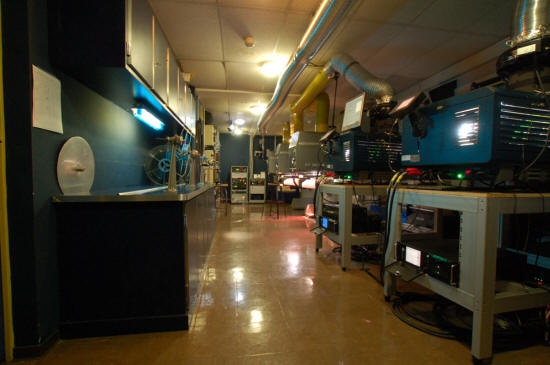 A
rare look into the main projection room of the Cannes Film Festival. 3 DP75s
and two digital projectors. A
rare look into the main projection room of the Cannes Film Festival. 3 DP75s
and two digital projectors.As time passed, I frequented a lot of cinemas and projection rooms where I acted as a substitute projectionist. In this way I got to know, all around the Paris neighbourhoods, an important number of projection rooms and various technical set-ups, and learned how to project movies in original versions, with French subtitles or dubbed in French. I used almost all types of projection equipment: 16mm, 35mm, 70mm (16mm and 35mm double band). When I was doing stand-in work I got to meet projectionists who were working for the Cannes Festival (who I would replace whilst they were going to Cannes). I asked them how I might myself apply to go to Cannes. As the head of projectionists at Cannes was working in a big cinema on the Champs-Elysees, “Le Paris”, I introduced myself to him and a few months later, in 1973, I had the chance to find myself as a projectionist at the Cannes. |
|
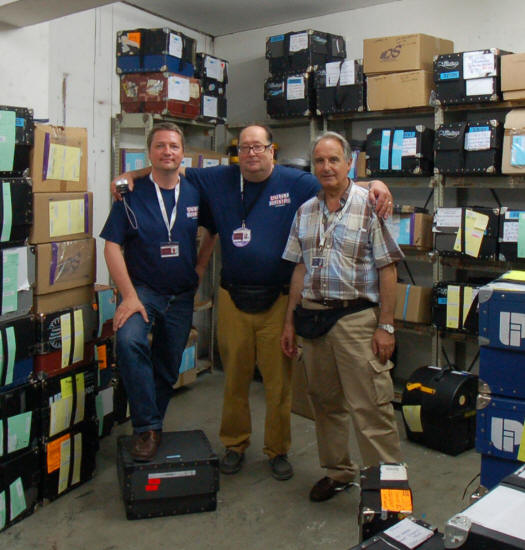 Thomas
Hauerslev, Francois CARRIN and Loïc LEDEZ in the festival film storage. The only 70mm
film available for test, is a faded reel from "West Side Story". Thomas
Hauerslev, Francois CARRIN and Loïc LEDEZ in the festival film storage. The only 70mm
film available for test, is a faded reel from "West Side Story".Shortly after that festival I was given the opportunity to become projectionist at the Kinopanorama in Paris, where I ran many 70mm films - the owner, Mr Pinton, was a great 70mm enthusiast. Before my time this theatre was famous for showing 3-strip Kinopanorama with changeovers - using six projectors. A few years later, in 1979, I became assistant to the head projectionist at the Cannes Festival, and remained in this post until 1983. I then became Chief projectionist at the new Palais de Festival for the first year of its operation. In 1984, as my predecessor was retiring, I took up the duties of the head of projectionists and projection rooms of the Cannes Festival. During my long career in projection rooms I have watched thousands of movies - often several times, and at all the festivals I attended, and am still attending, I have the opportunity to meet many great directors, actors, actresses and technicians. This year 2007 will be my 35th Cannes Festival and it is interesting that 2007 really confirmed the beginning of digital cinema.” |
|
|
Go: back
- top -
back issues
- news index Updated 22-01-25 |
|
